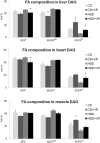Positive effects of voluntary running on metabolic syndrome-related disorders in non-obese hereditary hypertriacylglycerolemic rats
- PMID: 25830228
- PMCID: PMC4382201
- DOI: 10.1371/journal.pone.0122768
Positive effects of voluntary running on metabolic syndrome-related disorders in non-obese hereditary hypertriacylglycerolemic rats
Abstract
While metabolic syndrome is often associated with obesity, 25% of humans suffering from it are not obese and the effect of physical activity remains unclear in such cases. Therefore, we used hereditary hypertriaclyglycerolemic (HHTg) rats as a unique model for studying the effect of spontaneous physical activity [voluntary running (VR)] on metabolic syndrome-related disorders, such as dyslipidemia, in non-obese subjects. Adult HHTg males were fed standard (CD) or high-sucrose (HSD) diets ad libitum for four weeks. Within both dietary groups, some of the rats had free access to a running wheel (CD+VR, HSD+VR), whereas the controls (CD, HSD) had no possibility of extra physical activity. At the end of the four weeks, we measured the effects of VR on various metabolic syndrome-associated parameters: (i) biochemical parameters, (ii) the content and composition of triacylglycerols (TAG), diacylglycerols (DAG), ceramides and membrane phospholipids, and (iii) substrate utilization in brown adipose tissue. In both dietary groups, VR led to various positive effects: reduced epididymal and perirenal fat depots; increased epididymal adipose tissue lipolysis; decreased amounts of serum TAG, non-esterified fatty acids and insulin; a higher insulin sensitivity index. While tissue ceramide content was not affected, decreased TAG accumulation resulted in reduced and modified liver, heart and skeletal muscle DAG. VR also had a beneficial effect on muscle membrane phospholipid composition. In addition, compared with the CD group, the CD+VR rats exhibited increased fatty acid oxidation and protein content in brown adipose tissue. Our results confirm that physical activity in a non-obese model of severe dyslipidemia has many beneficial effects and can even counteract the negative effects of sucrose consumption. Furthermore, they suggest that the mechanism by which these effects are modulated involves a combination of several positive changes in lipid metabolism.
Conflict of interest statement
Figures


Similar articles
-
Conjugated linoleic acid reduces visceral and ectopic lipid accumulation and insulin resistance in chronic severe hypertriacylglycerolemia.Nutrition. 2015 Jul-Aug;31(7-8):1045-51. doi: 10.1016/j.nut.2015.03.011. Epub 2015 Apr 20. Nutrition. 2015. PMID: 26059381
-
Carnitine supplementation alleviates lipid metabolism derangements and protects against oxidative stress in non-obese hereditary hypertriglyceridemic rats.Appl Physiol Nutr Metab. 2015 Mar;40(3):280-91. doi: 10.1139/apnm-2014-0163. Appl Physiol Nutr Metab. 2015. PMID: 25723909
-
Saturated, but not n-6 polyunsaturated, fatty acids induce insulin resistance: role of intramuscular accumulation of lipid metabolites.J Appl Physiol (1985). 2006 May;100(5):1467-74. doi: 10.1152/japplphysiol.01438.2005. Epub 2005 Dec 15. J Appl Physiol (1985). 2006. PMID: 16357064
-
Dietary sardine protein lowers insulin resistance, leptin and TNF-α and beneficially affects adipose tissue oxidative stress in rats with fructose-induced metabolic syndrome.Int J Mol Med. 2012 Feb;29(2):311-8. doi: 10.3892/ijmm.2011.836. Epub 2011 Nov 11. Int J Mol Med. 2012. PMID: 22085913
-
Has natural selection in human populations produced two types of metabolic syndrome (with and without fatty liver)?J Gastroenterol Hepatol. 2007 Jun;22 Suppl 1:S11-9. doi: 10.1111/j.1440-1746.2006.04639.x. J Gastroenterol Hepatol. 2007. PMID: 17567458 Review.
Cited by
-
Beneficial Effect of Fenofibrate and Silymarin on Hepatic Steatosis and Gene Expression of Lipogenic and Cytochrome P450 Enzymes in Non-Obese Hereditary Hypertriglyceridemic Rats.Curr Issues Mol Biol. 2022 Apr 26;44(5):1889-1900. doi: 10.3390/cimb44050129. Curr Issues Mol Biol. 2022. PMID: 35678658 Free PMC article.
-
Voluntary physical activity counteracts Chronic Heart Failure progression affecting both cardiac function and skeletal muscle in the transgenic Tgαq*44 mouse model.Physiol Rep. 2019 Aug;7(13):e14161. doi: 10.14814/phy2.14161. Physiol Rep. 2019. PMID: 31267722 Free PMC article.
-
The effect of voluntary wheel running on the antioxidant status is dependent on sociability conditions.Pharmacol Biochem Behav. 2020 Nov;198:173018. doi: 10.1016/j.pbb.2020.173018. Epub 2020 Aug 20. Pharmacol Biochem Behav. 2020. PMID: 32827504 Free PMC article.
-
Non-alcoholic fatty liver disease: Insights from sphingolipidomics.Biochem Biophys Res Commun. 2018 Oct 7;504(3):608-616. doi: 10.1016/j.bbrc.2018.05.078. Epub 2018 May 21. Biochem Biophys Res Commun. 2018. PMID: 29778532 Free PMC article. Review.
-
The Vasoactive Role of Perivascular Adipose Tissue and the Sulfide Signaling Pathway in a Nonobese Model of Metabolic Syndrome.Biomolecules. 2021 Jan 15;11(1):108. doi: 10.3390/biom11010108. Biomolecules. 2021. PMID: 33467512 Free PMC article.
References
-
- Bray GA, Nielsen SJ, Popkin BM. Consumption of high-fructose corn syrup in beverages may play a role in the epidemic of obesity. Am J Clin Nutr. 2004;79: 537–543. - PubMed
-
- Albright A, Franz M, Hornsby G, Kriska A, Marrero D, Ullrich I, et al. American College of Sports Medicine position stand. Exercise and type 2 diabetes. Med Sci Sports Exerc. 2000;32: 1345–1360. - PubMed
-
- Katzmarzyk PT, Leon AS, Wilmore JH, Skinner JS, Rao DC, Rankinen T, et al. Targeting the metabolic syndrome with exercise: Evidence from the HERITAGE Family Study. Medicine and Science in Sports and Exercise. 2003;35: 1703–1709. - PubMed
Publication types
MeSH terms
Substances
LinkOut - more resources
Full Text Sources
Other Literature Sources
Medical

